Maggie Steele, the storybook heroine who vaults over the moon, has been attracting thousands of visitors from around the world. So many visitors, in fact, that she’s using a time zone map to keep track of them all.* People are … Continue reading ![]()
Viewing: Blog Posts Tagged with: ireland, Most Recent at Top [Help]
Results 51 - 75 of 104
Blog: (Login to Add to MyJacketFlap)
JacketFlap tags: Chile, Uncategorized, Canada, Japan, Taiwan, Amazon, Philippines, Mexico, France, Australia, India, Poland, Germany, New Zealand, Pakistan, Puerto Rico, Belgium, Spain, Slovenia, United Kingdom, Finland, South Africa, Brazil, Singapore, Nicaragua, Ireland, Netherlands, Italy, Turkey, Israel, Switzerland, Nigeria, Sweden, Indonesia, Mongolia, Thailand, Argentina, Morocco, Peru, Jamaica, Norway, Egypt, Indiebound, Iceland, Venezuela, Bahamas, Denmark, Greece, United States, Portugal, Czech Republic, Colombia, Romania, Croatia, Saudi Arabia, Hong Kong, Ukraine, Jordan, Yemen, Algeria, Hungary, Bermuda, Ecuador, Bulgaria, Estonia, Tunisia, Trinidad and Tobago, Girls Sports, Bahrain, Lithuania, Namibia, United Arab Emirates, Grant Overstake, Inspirational Sports Stories, Maggie Vaults Over the Moon, young adult sports, KSHSAA, Pole Vault Fiction, Track and Field Stories, sports novels, Recommended sports books for teens, Watermark Books and Cafe, Kansas State High School Activities Association Journal, Austria Botswana, Insirational Sports Books, Isle of Man, Republic of Korea, Russian Federation, Add a tag
Blog: Cartoon Brew (Login to Add to MyJacketFlap)
JacketFlap tags: Shorts, CGI, Ireland, Austin Kenny, Brown bag Films, Darragh O'Connell, Add a tag
Irish animation studio Brown Bag Films released its 2011 short 23 Degrees 5 Minutes online today. Based on a story by Austin Kenny, the CG short is directed by Darragh O’Connell, who has been twice nominated for the animated short Oscar for co-directing the films Give Up Yer Aul Sins and Granny O’Grimm’s Sleeping Beauty.
Add a CommentBlog: Sarah McIntyre (Login to Add to MyJacketFlap)
JacketFlap tags: ireland, interview, Add a tag
Hey look, I have an interview in Ireland's Inis (pronounced 'IN-ish') magazine with Cethan Leahy, including a piece of brand-new picture book artwork no one's seen before! Click here to read...
Thanks to the Irish book community for being so supportive of my work! I'm looking forward to a week in Ireland this May, where Children's Laureate Niamh Sharkey, French picture book man and sculptor extraordinaire Hervé Tullet and I will be running gloriously amok. More news about that later!
Blog: OUPblog (Login to Add to MyJacketFlap)
JacketFlap tags: Literature, joyce, ireland, OWC, ulysses, james joyce, Oxford World's Classics, Dublin, Irish Literature, bloomsday, Humanities, *Featured, the dubliners, a portrait of the artist as a young man, finn fordham, Finnegans Wake, Add a tag

By Finn Fordham
Joyce was obsessed with birthdays. Today, February 2nd, is his. An emerging secular saint’s day, it will be remembered and alluded to round the world – especially in Dublin — in the corners of newspapers and pubs, in blogs (like this one), tweets and the odd talk. Born in 1882, Joyce’s cake — if he could have one, let alone eat it — would have a hundred and thirty one candles; a hundred years ago, therefore, he would have been celebrating his 31st birthday. The image of candles is suitable, since Joyce’s birthday fell on ‘Candlemas’, a holy day which commemorates Christ’s first appearance in a synagogue with his mother, forty days after his birth, in part by the lighting of candles. Mary was following the Mosaic law which says that, after giving birth, a mother is not clean for forty days, at which point she is to be purified through sacrifice.
‘Celebrating’, however, might be too strong a word: in 1913, Joyce was, artistically, in something of a lull, and life might well have been frustrating. He was teaching English in Trieste, with two small children, aged 5 and 7. He was struggling to get Dubliners past timid publishers and printers; A Portrait…, begun some nine years before, was unfinished; Ulysses was not yet begun. He was writing the odd bit of journalism, but the high artistic ambitions he had cherished as a young man had taken a battering. He’d spent his twenty-first in Paris, receiving a letter written by his father John Joyce, which he would carefully keep wherever he went:
My dear Jim, May I be permitted to offer you my best wishes for your future which I, at one time, fancied may have been more rosey on your attaining your majority [i.e becoming 21]… I hope you will beleive [sic] me that I am only now, under I may tell you, very trying times, endeavouring to do my little best, but Jim you are my eldest Son I have always looked up to your being a fitting representative of our family one that my father would be proud of. I now only hope that you may carry out his ideas through your life and if you do, you may be sure you will not do anything unbecoming a gentleman.
John Joyce, here and in general, was, like Simon Dedalus in Ulysses, strong and open in his expression of emotion. He is not the stereotypical cold and detached Victorian father. On the other hand, the complexity of his warmth borders on ambiguity, and its intensity must have brought some pressure to the young and, by all accounts, lonely Joyce: the father feels responsible for failing his son, but implies that his son was failing, or in danger of doing so; he seeks forgiveness while sending his son on a guilt trip; he says he looks up to him, while also establishing a role model in his own father, thus reaffirming the patriarchal hierarchy of genealogy. Self-pityingly unable to help materially, he adopts the role of civic mentor — urging him to behave like a gentleman, as Polonius did to Laertes when the latter was about to go to Paris (and its fleshpots). Larkin’s term for such ambivalence was ‘sloppy-stern’.
 Birthdays may be a universal convention, but they are not universally liked. One pressure that birthdays bring is the inevitability, almost the duty, of self-reflection — a pressure which the Joyces, father and son, must have been aware of in 1903. The attention of others — fathers, mothers, friends, colleagues, wishing us well, presenting a gift, raising a glass — may exacerbate processes of self-examination and even pernicious comparison. Relative to where we were, or where we hoped to be, relative to our peers, or where our role models once were — where have we got to, or to what have we sunk? Birthdays are ciphers that multiply whatever condition we’re in. The potential trauma of birthdays repeats, perhaps compulsively, the trauma of the day of birth. The twitching nervous checking during labour of the condition of mother and child – how are they doing, what are their heart rates? — becomes a twitching nervous checking on birthdays of whether one has yet become oneself.
Birthdays may be a universal convention, but they are not universally liked. One pressure that birthdays bring is the inevitability, almost the duty, of self-reflection — a pressure which the Joyces, father and son, must have been aware of in 1903. The attention of others — fathers, mothers, friends, colleagues, wishing us well, presenting a gift, raising a glass — may exacerbate processes of self-examination and even pernicious comparison. Relative to where we were, or where we hoped to be, relative to our peers, or where our role models once were — where have we got to, or to what have we sunk? Birthdays are ciphers that multiply whatever condition we’re in. The potential trauma of birthdays repeats, perhaps compulsively, the trauma of the day of birth. The twitching nervous checking during labour of the condition of mother and child – how are they doing, what are their heart rates? — becomes a twitching nervous checking on birthdays of whether one has yet become oneself.
For an ambitious person, for someone intent on establishing a mythology of themselves, for someone superstitious, birthdays, especially their own, and other anniversaries are crucial. And so they were for Joyce, for these very reasons. He habitually made awkward deadlines for himself and his publishers, by wanting his books to appear on his birthday or, failing that, his father’s. The day on which Ulysses is set (itself the day of the troubled birth, though fictional, of Mortimer Edward Purefoy), is supposed to be the day of Joyce’s first date with Nora Barnacle, though their encounter is not in fact recorded in the fiction.
Through the cyclical repetition of dates, days become haunted, charged with the meaning of the events of the past, implicit in their dates: Armistice Day, Guy Fawkes, the Battle of the Boyne. The different calendars of the global village, now shared in multi-cultural societies, show the space of the year as an environment that is densely built up with official anniversaries which are the signs and the foundations of institutions, of nations, states, religions, organisations, movements.
Anniversaries seem inevitable because of the cycle of the year, but they are not guaranteed: different anniversaries can coincide on the same day, so that one feast day ousts another; secular festivals push out saints’ days. Joyce cheekily engineered such a coincidence in the birthday of Molly Bloom, which was September the 8th, the same day as the Virgin Mary’s birthday. Joyce’s love of birthdays is in part a wish to appropriate this map, a symptom of an eternal struggle he identified between the individual and society: ‘the state is concentric; man is concentric. Thence arise an eternal struggle.’
We have a Bloomsday, on which the institution of Joyce studies (and Joycolatry) are built. But there is no Wake-day: Finnegans Wake does not seem to happen on a single day, though for one critic it is a dream dreamt on 28 March 1938. For others the events of the Wake happen everyday and anyday. Unlike Ulysses, it has not been so easily institutionalised. Either way, it is certainly worth celebrating and lighting candles for: and Joyce’s birthday is as good as any to do so.
Dr Finn Fordham is Reader in 20th Century Literature at Royal Holloway, University of London. Along with Robbert-Jan Henkes and Erik Bindervoet, he has edited the Oxford World’s Classics edition of Finnegans Wake by James Joyce. Finnegans Wake is a book that reinvents the novel and plays fantastic games with the language to tell the story of one man’s fall and resurrection; in the intimate drama of Humphrey Chimpden Earwicker and his wife Anna Livia, the character of Ireland itself takes form. Joyce called time and the river and the mountains the real heroes of his book, and its organic structure and extraordinary musicality embody his vision. It is both an outrageous epic and a wildly inventive comedy that rewards its readers with never-ending layers of meaning.
For over 100 years Oxford World’s Classics has made available the broadest spectrum of literature from around the globe. Each affordable volume reflects Oxford’s commitment to scholarship, providing the most accurate text plus a wealth of other valuable features, including expert introductions by leading authorities, voluminous notes to clarify the text, up-to-date bibliographies for further study, and much more. You can follow Oxford World’s Classics onTwitter and Facebook.
Subscribe to the OUPblog via email or RSS.
Subscribe to only literature articles on the OUPblog via email or RSS.
Image credit: By Paweł Cieśla Staszek_Szybki_Jest (Own work) [CC-BY-SA-3.0-2.5-2.0-1.0], via Wikimedia Commons
The post James Joyce and birthdays appeared first on OUPblog.
Blog: OUPblog (Login to Add to MyJacketFlap)
JacketFlap tags: *Featured, abbey theatre, ann saddlemyer, Theatre & Dance, Arts & Leisure, j m synge, john millington synge, the playboy of the western world, the playboy riots, History, Literature, yeats, drama, ireland, OWC, playboy, Europe, Oxford World's Classics, Dublin, Irish Literature, Humanities, Add a tag

By Ann Saddlemyer
There had been rumours for months. When Dublin’s Abbey Theatre announced that John Millington Synge’s new play The Playboy of the Western World would be produced on Saturday, 26 January 1907, all were on alert. Controversy had followed Synge since the production of his first Wicklow play, The Shadow of the Glen, in which a bold, young, and lonely woman leaves a loveless May/December marriage to go off with a fine-talking Tramp who rhapsodizes over the freedom of the roads. Irish women wouldn’t do that!
In The Playboy the action takes place in a public house on the wild coast of Mayo, when a travel-stained stranger enters and is persuaded to tell his story. Impressed, the admiring on-stage audience thinks he must be very brave indeed to have killed his father, and in turn the young tramp blossoms into the daring rollicking hero they believe him to be – winning all the prizes at the races and the love of the publican’s daughter. But then his father, with a bandaged head, turns up seeking his worthless son who is not the courageous father-slayer after all. Disillusioned and angry at the loss of their hero, the onstage crowd turns brutally on Christy, who tries to prove that he is indeed capable of savage deeds, even attempting unsuccessfully to kill his father a third time. The play ends with father and son leaving together, dismissing the onstage audience with the words “Shut yer yelling for if you’re after making a mighty man of me this day by the power of a lie, you’re setting me now to think if it’s a poor thing to be lonesome, it’s worse maybe to go mixing with the fools of earth”.

Irish actors Sara Allgood (“Pegeen Mike”) and J. M. Kerrigan (“Shawn Keogh”), in ‘The Playboy of the Western World’, Plymouth Theatre, Boston, 1911.
Yet the playwright does not seem to have been aware of the response his play would cause, insisting that it was merely a comedy, an “extravaganza”, meant to entertain, and that “the story — in its ESSENCE — is probable, given the psychic state of the locality.” Not to this audience, who charged him with immorality, obscenity and blasphemy, “a sordid, squalid and repulsive picture of Irish life and character”, making a hero of “a foul-mouthed scoundrel and parricide”.
For three years Synge had painstakingly developed his original idea, producing more than a thousand typescript pages, drafts and scenarios, all the way to draft “K” before he finally hit on the brilliantly ambiguous final form. For a “playboy” may be an athlete, performer, seducer, trickster, manipulator, creator, hero, or all of the above; while “the western world” might refer to County Mayo, to the United States, or to this world as contrasted with that “eastern world” of folk and fairy tales — or to all. “What a blessing you did not go to version L, if Version K had such a disastrous effect!” a friend commented in the turbulent months that followed.
Like Christy’s own tale of slaying his Da, the story of his injuries to Ireland’s good name continued to grow with the years. When the Abbey theatre took the play on tour to the United States, the clash between the idea of a pure nationhood cherished by Irish immigrants and what they saw on stage was even more pronounced. In New York missiles were thrown on the stage, and a hundred police attempted to keep order. Lady Gregory, who led the tour, received death threats; Theodore Roosevelt’s presence at the second performance ensured a more sedate reception. But when the company arrived in Philadelphia all hell broke loose, and the players were hauled into court by an Irish-American patriot who accused the company and the play of indecency. The case was dismissed when the judge learned that the accusers had not read the text.
In the theatre individual response to what is clearly not real can quickly become an excuse for objecting to what is perceived to be real. Audiences have always felt justified in expressing their disapproval of what is staged, or attempted to be staged. In 18th century London theatre managers petitioned the King for a guard of soldiers; one manager engaged thirty prize-fighters as well. Destruction of scenery, benches and even musical instruments was all too common when the audience felt cheated; often foreign performers were pelted with rotten fruit and other missiles (and told to go home).
Patriotism was perhaps the most frequent cause, especially in Ireland where the stage Irishman, created by English dramatists, was a subject of mockery and ridicule, and where class, nationalism, and religion were inextricably entwined. In 1907 however the disturbance was premeditated, with members of the audience carrying in stink bombs, rotten vegetables, trumpets, whistles, and other paraphernalia. There was clearly an organized cabal determined to silence a work which is now considered a masterpiece of comedy, performed throughout the world and recently the centrepiece of a world tour.
Would such events happen today? We are much more accustomed to onstage violence; but censorship is still very much with us. Synge suggests that to hold a dream is better than to live with caution; the outsider serves to perpetuate the myth-making process while at the same time challenging it, introducing a heightened self-awareness which embraces community on both sides of the footlights. Thus the audience is caught off-guard, encouraged to enter the world of fantasy, then betrayed by a reality of a different sort — the dream itself can threaten if fulfilled; we are briefly dangled above two worlds at once.
Ann Saddlemyer has published extensively on Irish and Canadian theatre and edited the plays of Lady Gregory and the letters between the founding Directors of the Abbey Theatre. Her book Becoming George: The Life of Mrs W.B. Yeats was shortlisted for the James Tait Black Memorial Prize for Biography. She has most recently edited W.B. Yeats and George Yeats: The Letters. She is the editor of the Oxford World’s Classics edition of Synge’s The Playboy of the Western World and Other Plays.
For over 100 years Oxford World’s Classics has made available the broadest spectrum of literature from around the globe. Each affordable volume reflects Oxford’s commitment to scholarship, providing the most accurate text plus a wealth of other valuable features, including expert introductions by leading authorities, voluminous notes to clarify the text, up-to-date bibliographies for further study, and much more. You can follow Oxford World’s Classics on Twitter and Facebook.
Subscribe to the OUPblog via email or RSS.
Subscribe to only literature articles on the OUPblog via email or RSS.
Image credit: From the Isabella Stewart Gardner Museum Archive, Boston [Public domain], via Wikimedia Commons
The post The Playboy Riots of 1907 appeared first on OUPblog.
Blog: the enchanted easel (Login to Add to MyJacketFlap)
JacketFlap tags: girl, tree, birds, sketch, children's art, st. patrick's day, kawaii, rainbow, irish, ireland, whimsical, shamrocks, original painting, nursery art, the enchanted easel, Add a tag
Blog: OUPblog (Login to Add to MyJacketFlap)
JacketFlap tags: northern ireland, British history, belfast, *Featured, irish history, ulster, Good Friday Agreement, modern history, Orange Order, philip ollerenshaw, Plantation of Ulster, sectarianism, ulster since 1600, United Irishmen, 1600, History, UK, politics, ireland, society, economy, Add a tag
By Philip Ollerenshaw
For many people the terms Ulster, Northern Ireland, and ‘the North’ conjure up images of communal conflict, sectarianism, and peace processes of indefinite duration. More than 3,500 people were killed in the national, communal and sectarian conflict that engulfed Northern Ireland between 1969 and Easter 1998 when the Good Friday Agreement was signed. Tens of thousands were injured or maimed, while sporadic acts of political violence persist to this day.
The near-present is a powerful influence on how we view the past. Yet, in many respects, these blood-spattered years serve to distort our understanding of the lived experience of people in Ulster from 1700 onwards. True enough, this was an ethnically-divided society, but one characterised by complexities, ambiguities, contrariness and the unexpected. Above all, it is necessary to appreciate that violence was not the dominant motif in most time periods in recent centuries.
In 1600, Ulster was a thinly populated, economically backward region. By 1900, without the benefit of local coal or iron, the Belfast region had emerged as a significant industrial and commercial centre in western Europe. This social and economic dynamism was based, first, on linen textiles and later on shipbuilding and engineering. Elsewhere in Ulster, more traditional but vigorous small-farming enterprises predominated.
The story of Ulster since 1600 is one of dramatic transformation, in which immigrant entrepreneurs and workers played a vital role. Moreover, in terms of economic geography and social networks, east Ulster was well placed to benefit from the English and Scottish industrial revolutions. In fact, the north east of Ireland was the only part of the island of Ireland to experience modern industrialisation and urbanisation on a major scale. By the time of political independence in ‘southern’ Ireland, Belfast stood out as Ireland’s only industrial city.
But here is one of the many paradoxes. Despite these modernising tendencies, Belfast and the lesser towns of Ulster incubated and perpetuated forms of politico-religious conflict that have outlived similar tendencies that were once characteristic of many parts of western Europe.
There are other paradoxes. The economic trajectory of Ulster in the eighteenth century, though marred by periodic crises, was generally upwards. Yet the province of Ulster experienced higher levels of emigration, particularly to North America, than any of the other Irish provinces. These emigrants, Presbyterians in the main, went on to forge other lives in the New World. A disproportionate number were involved on the insurgents’ side in the American war of independence. At home, a minority of Presbyterians were active in the radical United Irishmen, seeking reform of the Anglican and landlord-dominated Irish political system.
Presbyterian radicalism took a new turn in the following century, focusing on reform of the landlord and tenant system and local government, but within the framework of the Union of Britain and Ireland. The industrial success of east Ulster in turn served to solidify support for the Union, among Protestant workers as well as captains of industry, aided by a resurgent Orange Order. The comparative underdevelopment of the south and west of Ireland provided ideological justification for emerging Irish nationalist and Catholic opposition to the Union. It is significant, though, that members of the Catholic working class in Belfast, Derry and Newry were not swayed by economic arguments. In conjunction with their co-religionists, they sought Home Rule and later political independence for all of Ireland.
The partition of the island in 1920-21, with six of the original nine Ulster counties forming the new statelet of Northern Ireland, was a major source of grievance to Irish nationalists, North and South. Yet much of social and cultural life proceeded as before – arguably the continuities were as important as the discontinuities – though the heat and invective of political partisanship was sometimes imported into activities as diverse as sport, schooling and language revival.
The formative phase in the making of modern Ulster was undoubtedly during the Plantation of Ulster. But maybe Ulster was a place apart, even before then, as Estyn Evans has suggested? Indeed has the distinctiveness of Ulster in recent centuries been overstated, as some others have suggested? These, and many other questions, find at least partial answers within the pages of Ulster Since 1600.
Philip Ollerenshaw is Reader in History at the University of the West of England, Bristol. He is the author or editor of several books on economic, financial, and urban history, including Ulster since 1600: Politics, Economy, and Society (co-edited with Liam Kennedy; OUP, 2012) .
Subscribe to the OUPblog via email or RSS.
Subscribe to only British history articles on the OUPblog via email or RSS.
Subscribe to only history articles on the OUPblog via email or RSS.
The post Ulster since 1600: politics, economy, and society appeared first on OUPblog.
Blog: Sarah McIntyre (Login to Add to MyJacketFlap)
JacketFlap tags: ireland, festivals, dublin, reeve, Add a tag
So here are the top superheroes behind one of the best book festivals I've ever been to! Meet Tom Donegan and Sarah Webb, Ireland's ultimate dream team: 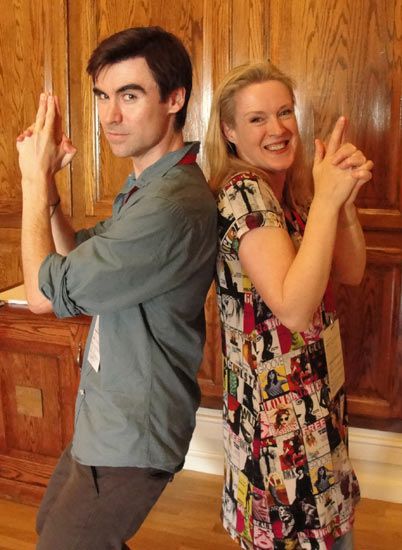
The sun was shining bright and Dun Laoghaire (pronounced 'dun LEER-y'), just next to Dublin, felt like being on the Mediterranean riviera. And I got to hang out with one of my best friends, writer Philip Reeve! We strolled along the promenade with Irish filmmaker Frank Kelly, who kindly agreed to take this author photo for the book I'm working on with Philip right now, Oliver and the Seawigs. My studio mate, Gary, just looked over my shoulder and said I look like a mermaid, so that's perfect. 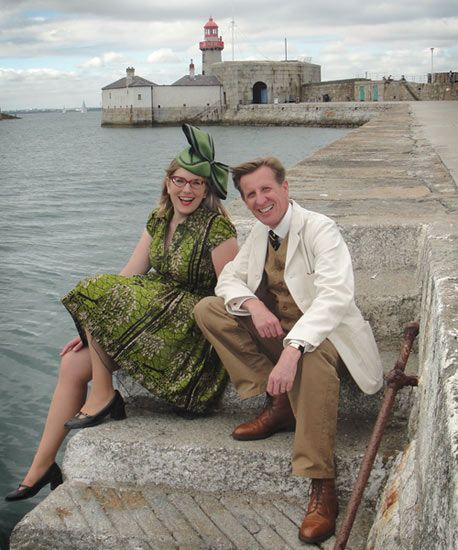
On the first evening, Tom and Sarah took me for dinner with Philip, writer Marcus Sedgwick and top librarian Dr Marian Thérèse Keyes, who took the photo. 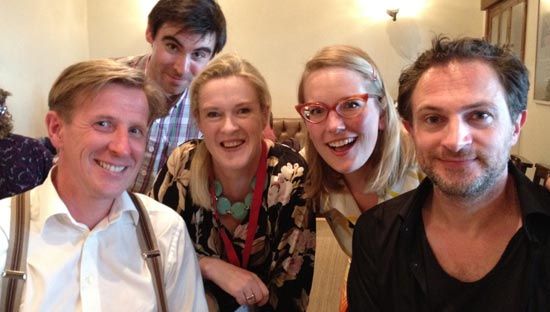
After dinner, Marcus, Philip and I went along to hear Sarah Webb talk about her book and writing, along with lots of other writers for adults and young adults, including Cathy Kelly, Katie Fforde, Vanessa Fox O’Loughlin, Sinéad Moriarty and Marita Conlon-McKenna. Our dinner had run overtime a bit, so we were sitting way, way in the back and couldn't see all that much. The panel gave a great talk, but the three of us were quite jolly from dinner and I made stupid drawings of us.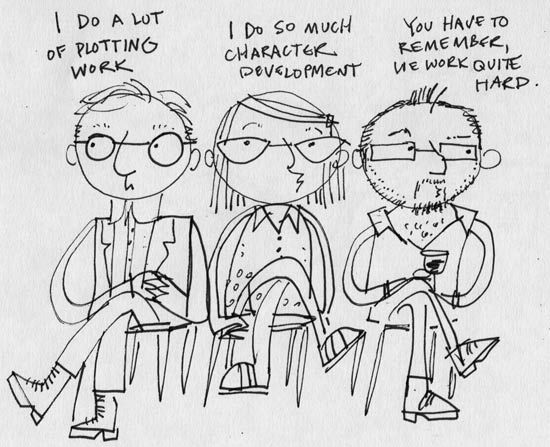
The next morning, Philip and I did a big MONSTERS & GOBLINS stage event, in front of something like 300 kids. It was loads of fun! Here's Philip with a miniature version of a bratapult, a weapon of war which plays quite a key part in his Goblins book. In fact, his main character spends something like two chapters falling after being hurtled from such a device. We fired goblins into the audience to make some merry chaos.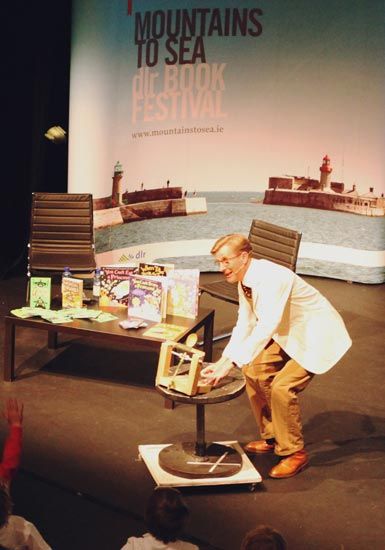
At two different events, we introduced ourselves while the other person drew an attractive portrait. We weren't allowed to look at our portrait until it was finished. You can get a glimpse over my shoulder here of Philip's drawing of me, which set the kids in the audience absolutely howling. 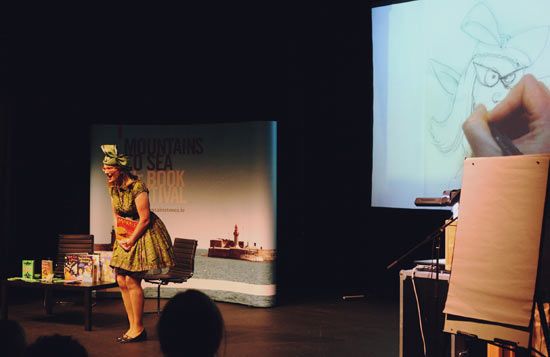
I grossed out the kids with a reading from Morris the Mankiest Monster and then the kids helped us invent new monsters, and Philip and I took turns drawing how we thought some of the characters in Goblins might look, including Trolls and Boglins. Here's Philip's Boglin. 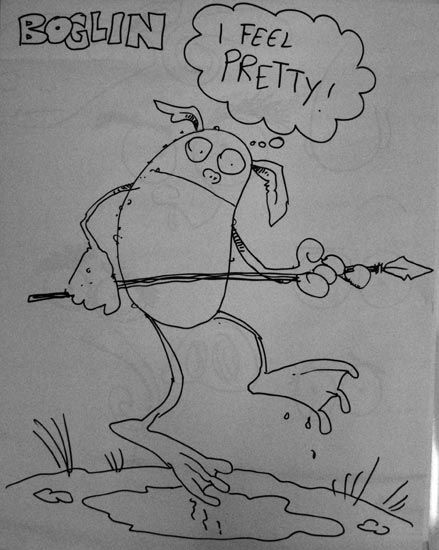
Then we turned the kids into a tribe of goblins by having them each design a goblin face. 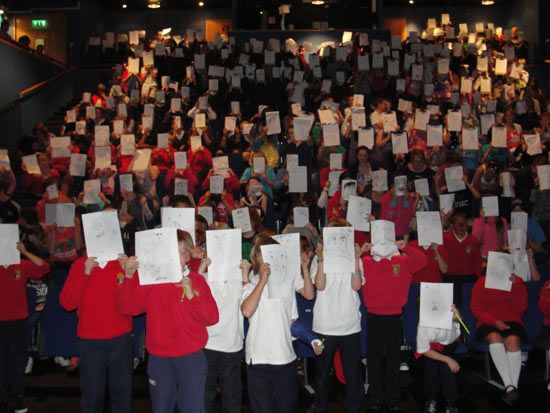
It was fun seeing the kids' work when they came up to get their books signed. 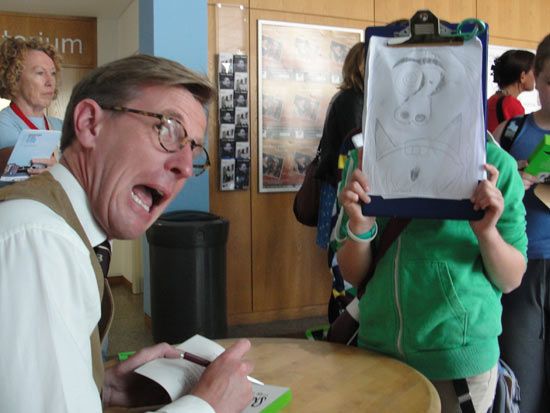
Hee hee! 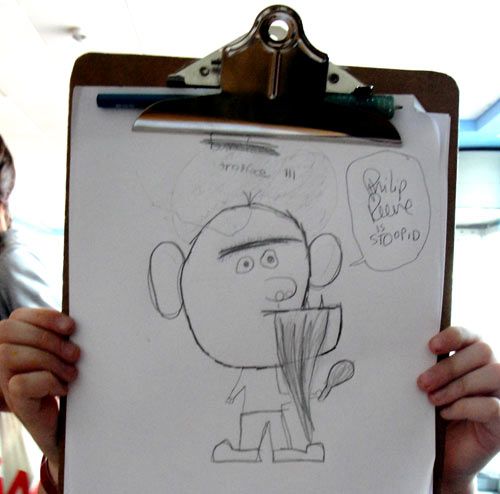
As ever, I can't post photos of the schoolchildren's faces, which is a shame, but they look quite nice with books for heads. 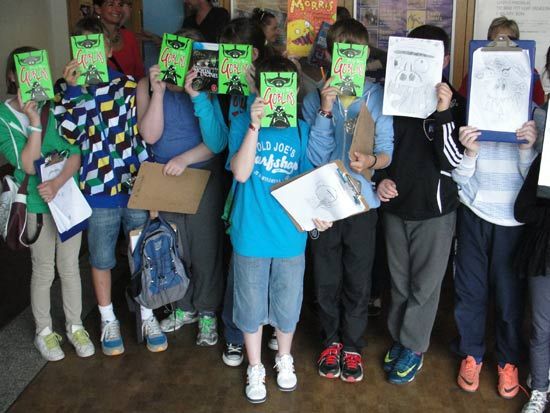
After the show, we recorded an interview for national television, RTE2's Elev8 programme (the same show Gary Northfield and I took part in a couple years ago, which you can see here). It'll go live in the show's next season, probably some time in October. Here are camera crew Elaine Buckley, Julian Hills and Orla Morris-Toolen. 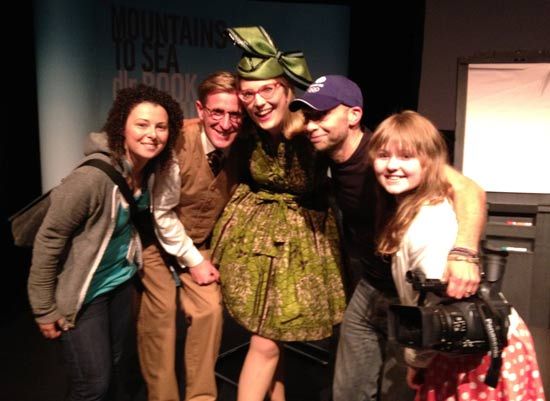
Orla (in the polka-dot dress) was an amazing interviewer; the camera crew would ask her to do something a bit different, and she'd quickly think about it and come up with a good way to ask us a question that fitted in well with the flow of the programme. Not many kids can think on their feet as calmly as that, I was really impressed.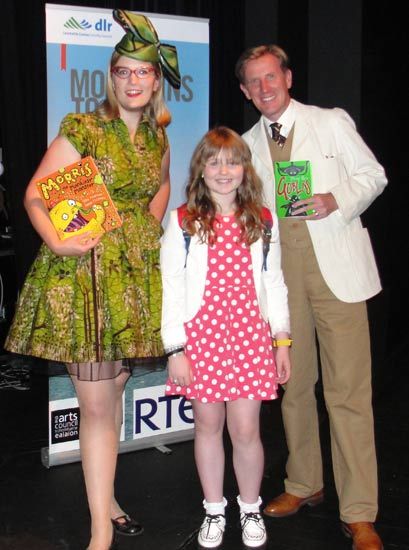
Later on in the festival, I ran into Moldovan Elev8 presenter Diana Bunici, who'd interviewed Gary and me last time. You can follow her on Twitter as @DeeBTweets and read her blog here. 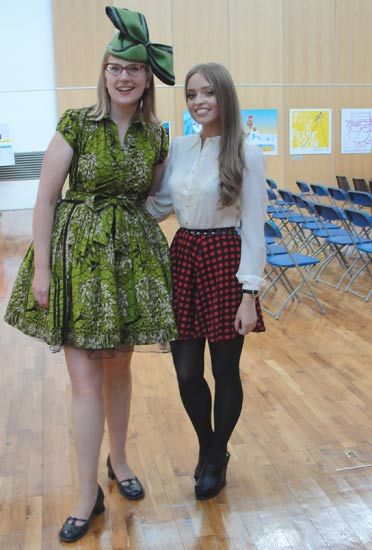
And here's the fabulous illustration exhibition Tom Donegan put together in the County Hall! Scholastic UK let the festival have sneak peeks at two spreads in my new book, Superkid with Claire Freedman, coming out next spring. Here they are, printed up large: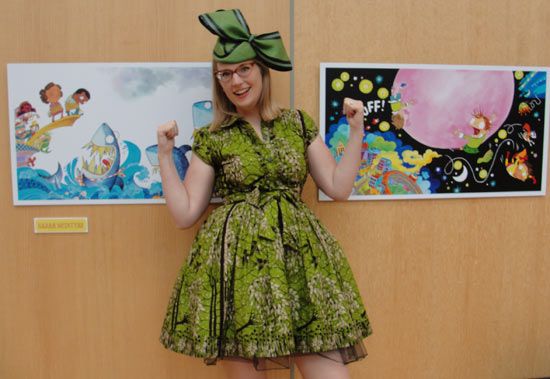
Both times Philip and I had some time off, we took the chance to stroll along the beautiful Dun Laoghaire harbour. Philip took a photo of me in front of this big sea urchin sculpture and said I looked like something painted on the front of a B-52, the thought of which pleases me to no end.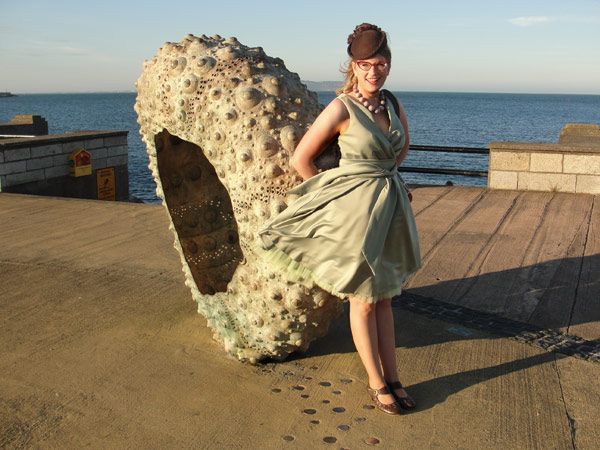
You can just about see the James Joyce Tower in the background. I really should know what this is. *Makes note to self to try to get into Ulysses again, despite several failed attempts*
And here's some of the jolly gang from Children's Books Ireland! Mags Walsh, Jenny Murray (and Aoife (pronounced 'EEF-ah') Murray arrived a bit later); bookseller and blogger Kim Harte, can someone remind me who that nice gentleman is?, and Tom. 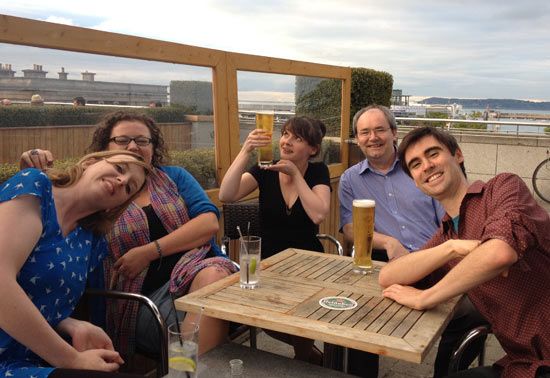
The next day, Philip and I led a Comics Jam workshop in the lovely posh yacht club, with about 20 kids. 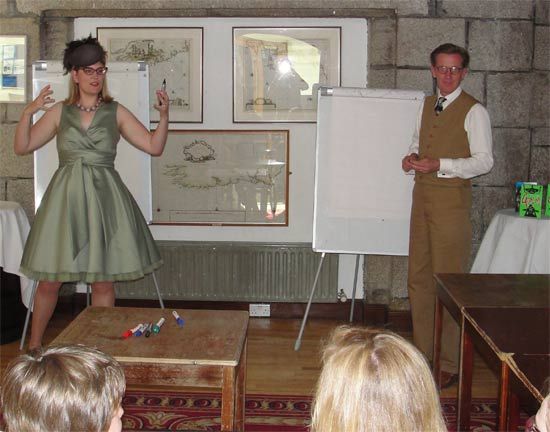
We started out by talking about character design. Here's one Philip drew: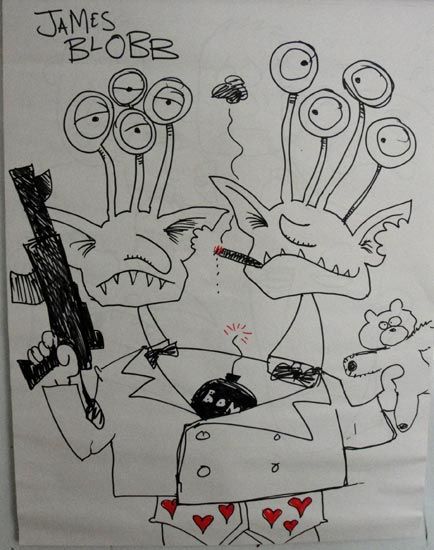
And a kid's drawing. Isn't it fabulous?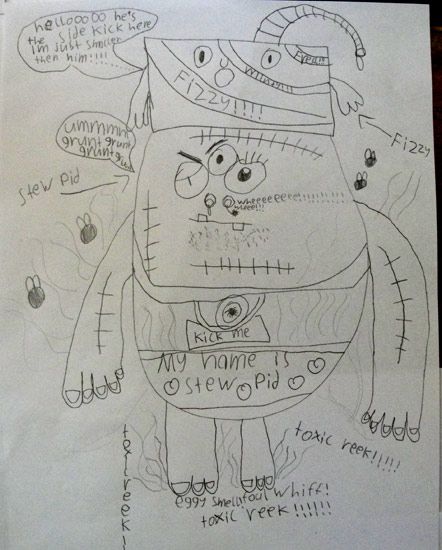
Then we took our characters and put them into a comics story. Here's one Philip and I bashed out at great speed, taking turns with each panel, with story material based on suggestions from the kids. 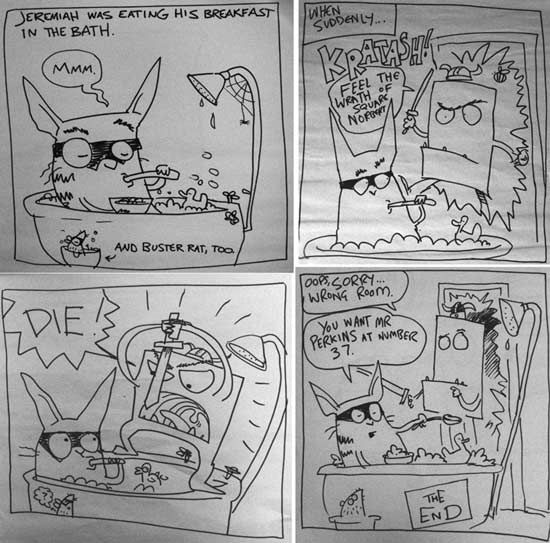
Then we set the kids off on their Comics Jam! 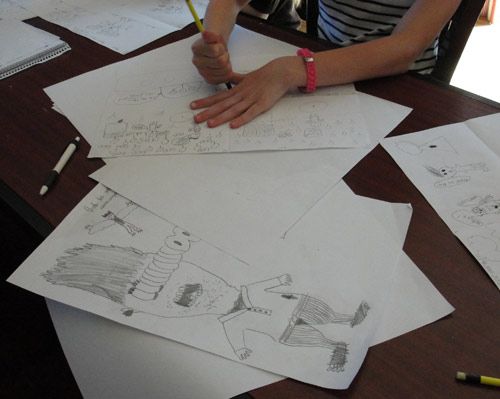
They had five minutes to draw a panel, then everyone passed their papers to the next person and for the next five minutes in the second panel, took up the new story where their neighbour had left off. 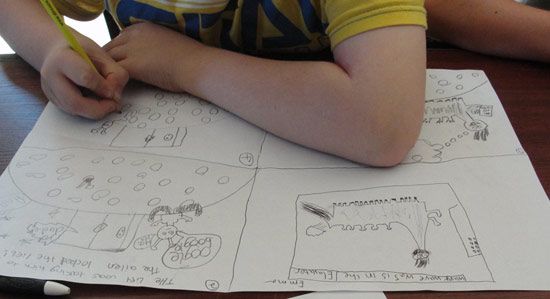
And so on, passing every five minutes until the four panels were filled.
At the end of 20 minutes, they had some great results. Here's one that made us laugh.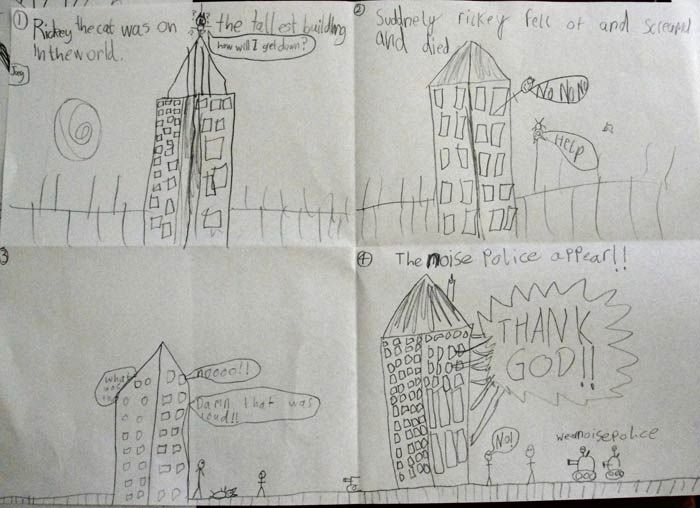
One of the cool things about doing events is meeting kids who are really stuck into comics already. Here's Finn, who brought along his notebook to show us and will obviously be an awesome comics artist if he keeps working as hard as he's doing now. 
I was thrilled to see he'd been studying my favourite comic strip, Calvin & Hobbes. Copying is a great way to learn in detail how another artist works, and I remember copying pages and pages of Archie comics when I was his age. 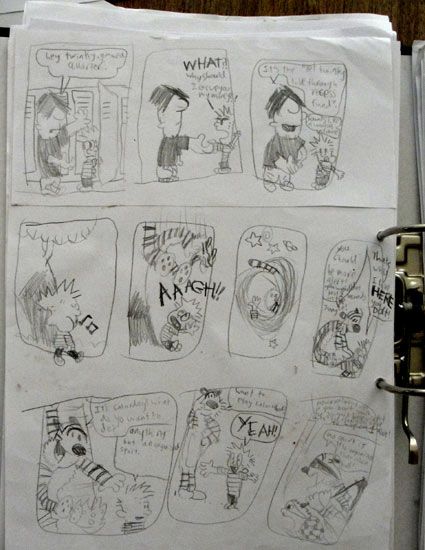
And he's coming up with great stuff of his own! Philip laughed and pointed out this Will-You-Need-a-Gas-Mask-o-Meter. 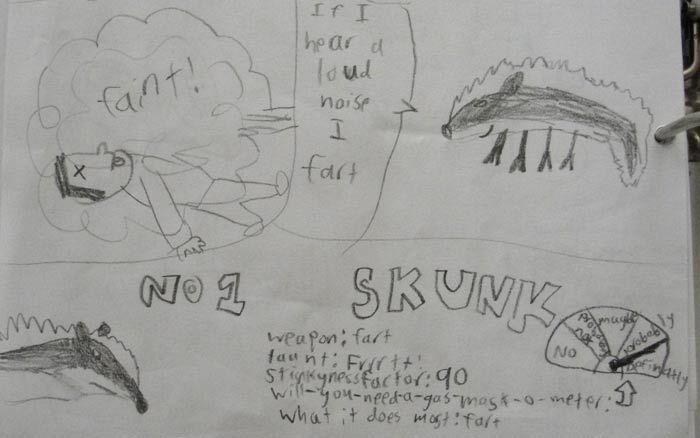
You can definitely see the influence of other comics on Finn's work, and it's great to see how he's exploring them and starting to add his own creative elements. Look out for this guy, he made be making appearances at small press comics fairs in the next few years. 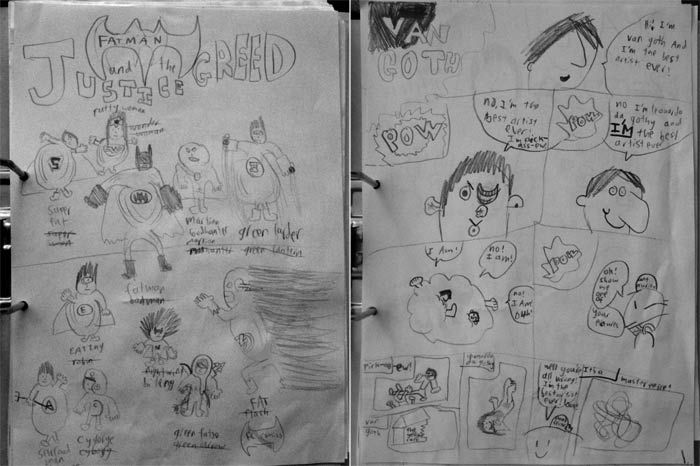
After our comics jam, we met up with lots of other writers on the yacht club deck to go for the Monster Book Lunch. I didn't get to talk with them as much as I would have liked to, but that's Claire Hennessey on the left (whom I hardly got to meet), someone (can anyone tell me who?) in the middle who I didn't really get to meet at all, and Judi Curtin, with whom I chatted briefly and is really lovely. Apparently her books are as popular in Ireland as Jacqueline Wilson's books are in England, so look out, English people, you might be seeing more of this lady. 
When I walked into the lovely banquet room, I was kind of expecting the table I was sharing with Philip Reeve to be packed with girls in tea party dresses. And most of the tables were like this, except ours, which was entirely seated with ROWDY BOYS. Ha ha! They were gentlemen enough to warn me not to drink the squash, which had salt and pepper added to it. 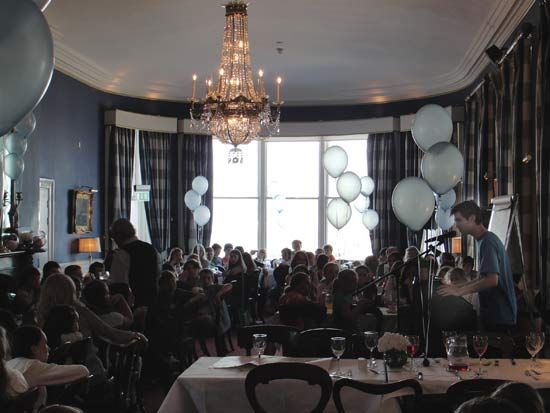
At most tables, the esteemed writers were having gracious conversations with their table mates, but that wasn't going to happen at ours. Instead we played a Monster Consequences game, and made some pretty awesome creatures. 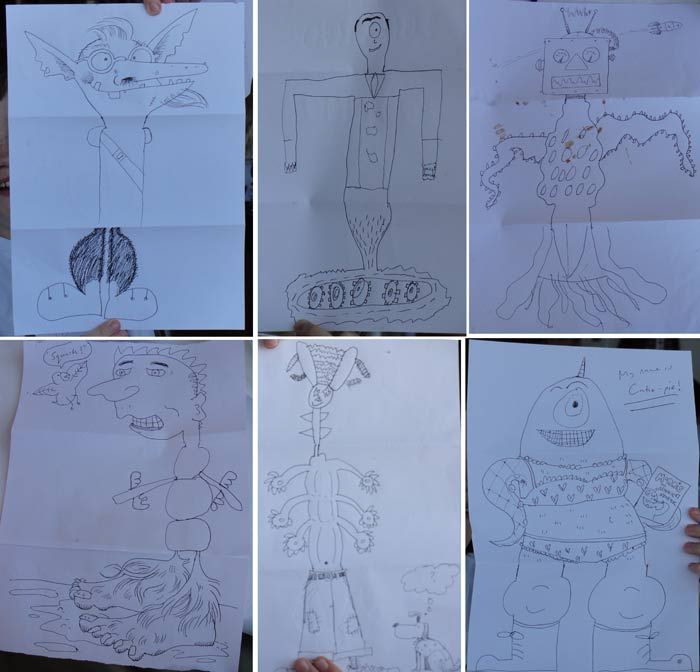
It was loads of fun meeting kids who already knew my work, including Shauna here, who was a huge fan and sent me a lovely e-mail which I read on my phone at the airport on the way home.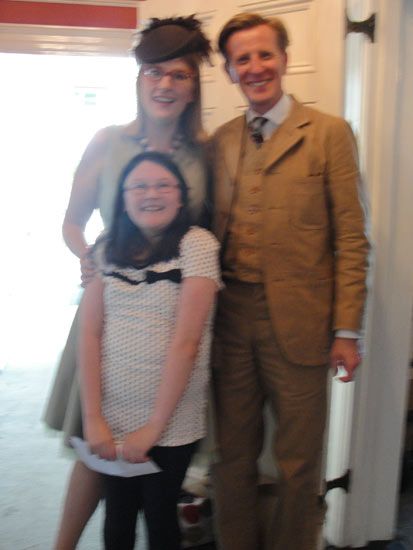
Here's our marvellous bookseller for the festival, the ever-energetic Bob Jonstone, who runs The Gutter Bookshop in Dublin's Temple Bar area. His shop's been getting lots of publicity and winning loads of awards recently, and he and his team ran the whole book sales side of things completely smoothly. Thanks, Bob! 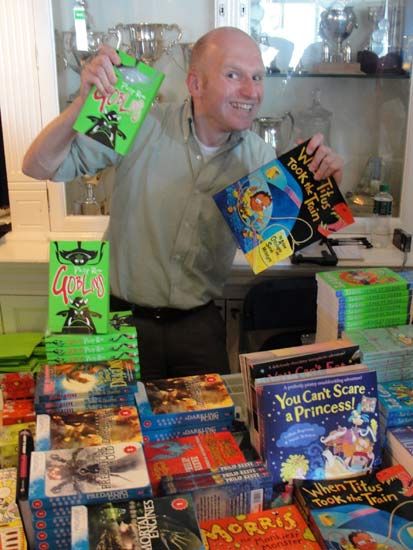
I left the Monster Book Lunch a bit early to do another Comics Jam workshop for older kids than the first one I'd done with Philip. Finn was there, but the rest were teenagers and a couple adults. They'd come to hear Steve Simpson give a talk on Superhero Illustration, but he had a family emergency, and the people at the workshop were great about letting me step in. Here are a couple of the Comics Jam results: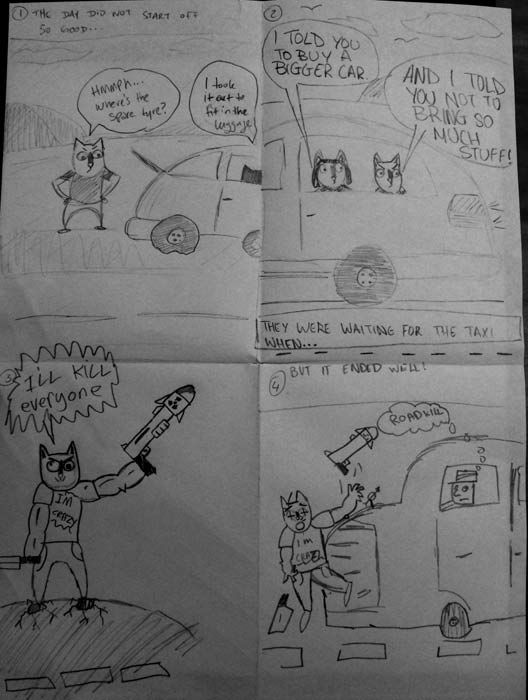

Meanwhile Philip Reeve was getting ready to go on a panel with writer Michelle Harrison, and I managed to dash in to listen, just as they were getting going. 
The panel was a project for the three girls interviewing Michelle and Philip. They'd had the chance to choose writers they'd like to interview, get them invited to the festival, and spend quite a lot of time preparing for the interview. They knew the writers' books well, and were able to ask some great questions. 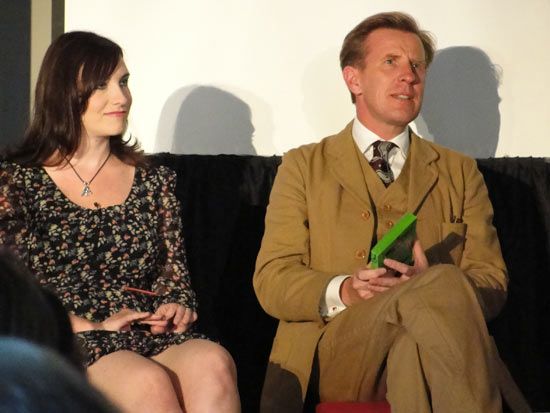
I was interested to find out that, like Philip, Michelle also does some illustration (as does Marcus Sedgwick, whom I mentioned earlier). And both she and Philip were very influenced by the early work of Brian Froud, who designed the looks for The Dark Crystal and Labyrinth films. Michelle writes a lot of horror stuff, and read from her recent book, Unrest, inspired by the sleep disorders she's encountered in people she knows. Here's the trailer video, and you can find out more over on her website.
Here's the fab panel, being VERY SCARED. 
Or is that speakers being VERY SCARY?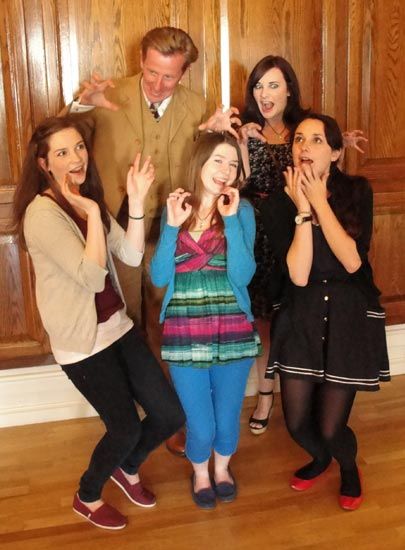
One of the great things about Mountains to Sea is that the festival's all within walking distance and everyone stays at the same place. So we were always bumping into people, including the writer Eoin Colfer (creator of Artemis Fowl), who wasn't even taking part in the festival this year! 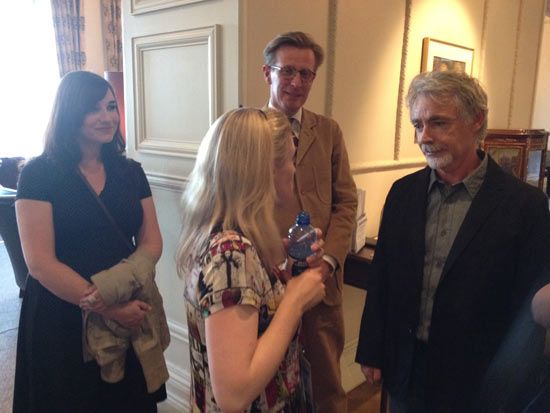
Here's the Royal Marine Hotel, a lovely Victorian candybox of a place: 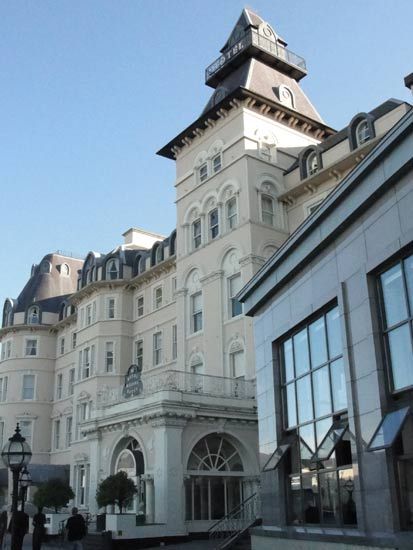
I got to sit across from Michelle at dinner, and meet writer Robert Muchamore. I didn't really know Robert's work, but he's the writer of the Cherub graphic novels, which my friend John Aggs illustrates, so it was great to meet him. Michelle (@MHarrison13) tweeted: Sat next to @RobertMuchamore at dinner earlier. He threw olives at me and pulled my hair. ...I think I will say nothing about that.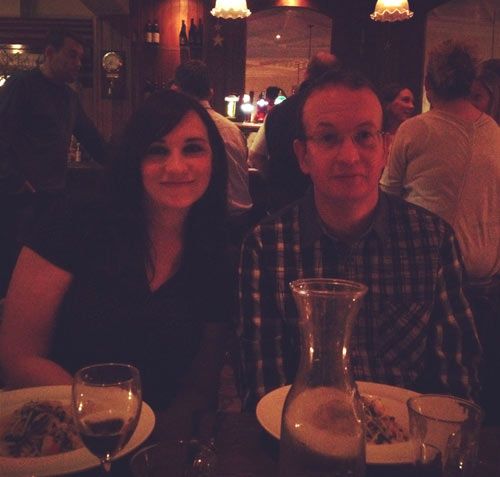
The next day, writer-illustrator Chris Judge and I went to the People's Park to take part in the Picture Book Picnic. I'd met Chris once before, at the festival at Tales on Moon Lane, but I'd been so busy keeping my group of kids from dumping paint on the bookshop floor that I didn't have much time to see him in action. 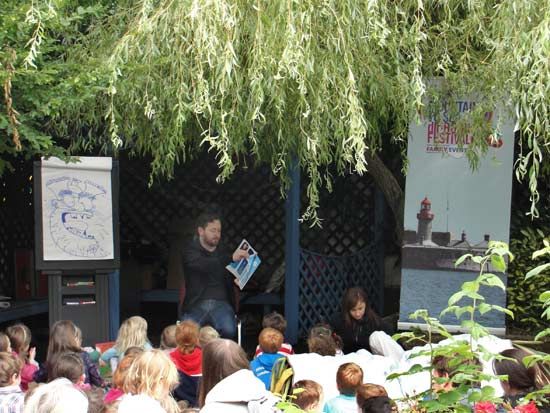
Here I am, reading from You Can't Scare a Princess. 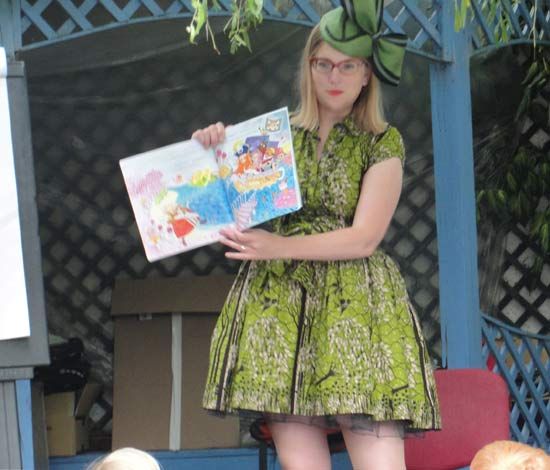
Chris did a great job reading from The Lonely Beast and The Great Explorer and getting the kids to respond. 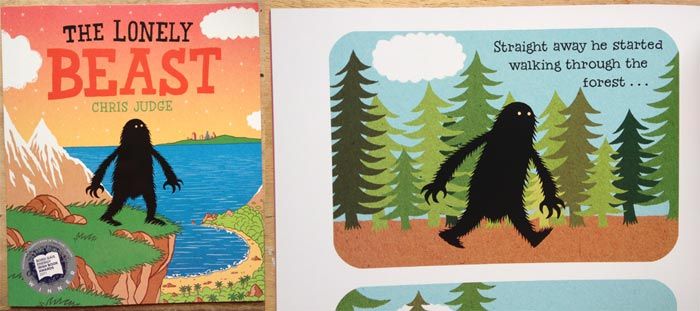
It was so obvious that all the kids, parents, festival volunteers, everyone, really love him. That's something so nice I'm noticing about Ireland. They don't have a huge home-grown publishing scene, but those they do have, they really get to know and cherish them. I really like that. 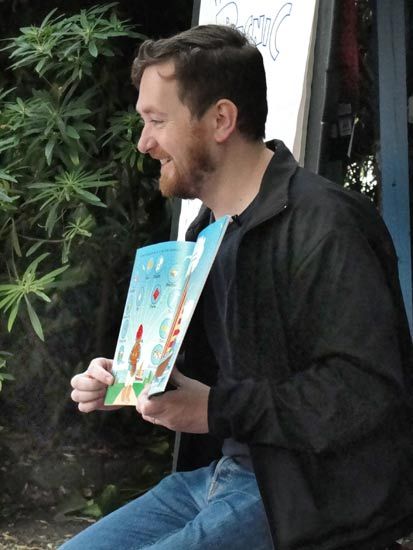
We both did some drawing with the kids. Here's Chris showing us how to draw the walrus from his book.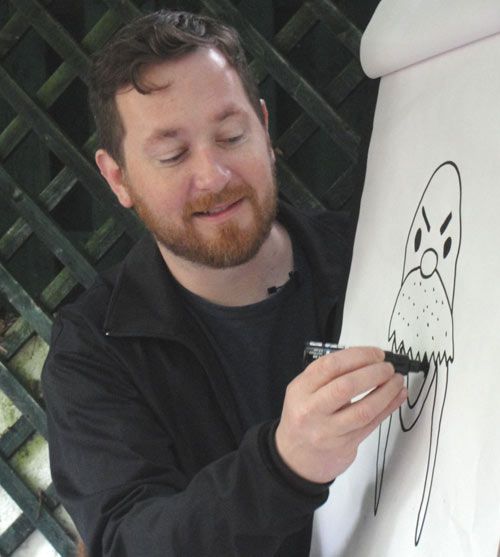
So many kids showed up that some of them had to share clip boards. I love this photo.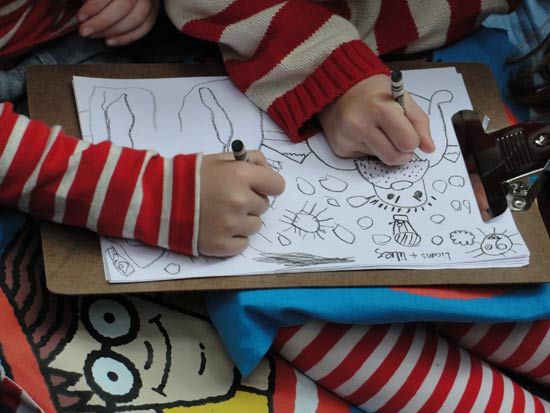
And this one, too. The team of volunteers was brilliant. And can I just say that if I was making an epic action film, I would want to cast this awesome-looking one in the lead role? This is designer-illustrator Simone Crowley and I spent some of the picnic admiring her and her tattoos from afar. 
And one more photo with Chris. The weeping willow in the Secret Garden section of the park made for a wonderfully atmospheric storybook kind of place. 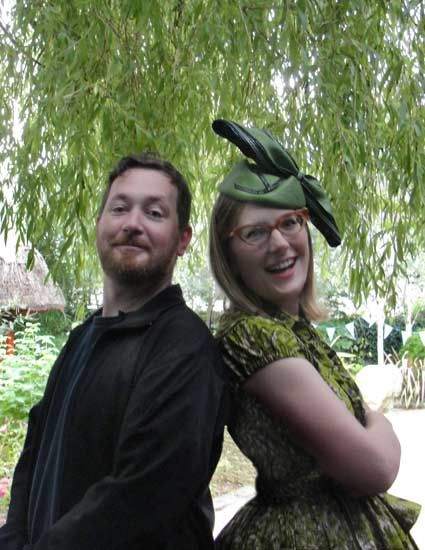
After the picnic, Tom and a lovely volunteer named Jenny hustled me off to County Hall for The Big Picture Panel Discussion with Chris, Inis magazine editor David Maybury and David Mackintosh. 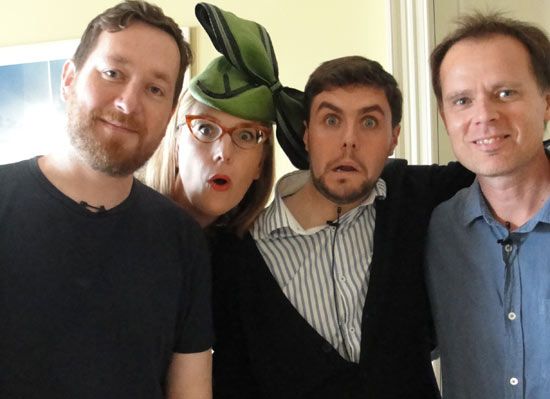
No event involving the whirlwind that is David Maybury can be anything other than terribly exciting, and this panel was no exception. The best part for me was finding out about David Mackintosh's work. I'd never even heard of him, but his books are SO beautiful. 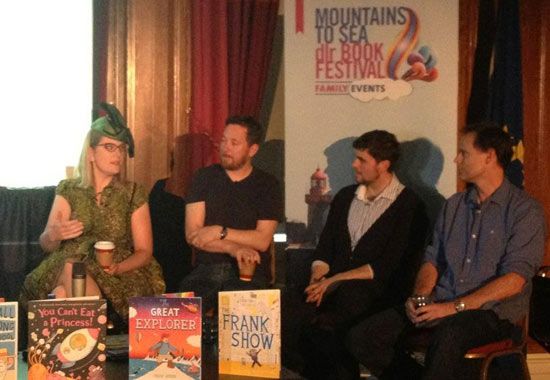
David's now London-based, but he was born in Belfast and grew up in Australia. And he worked as a graphic designer before moving into making his own picture books. And you can really tell: his understanding of typography, colour, how to use space on the page is exceptional. 
I'm already such a fangirl. Here's the dedication in one of the books I bought: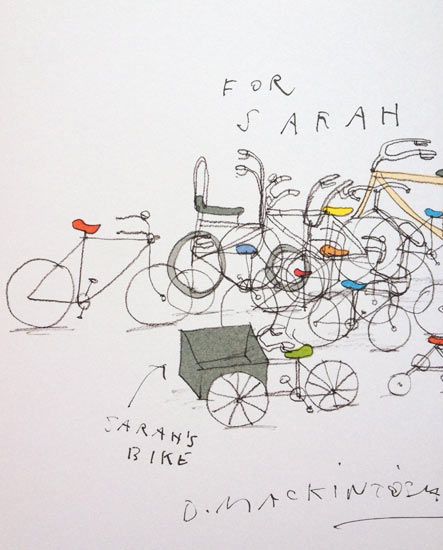
Aren't these pictures the best thing ever? 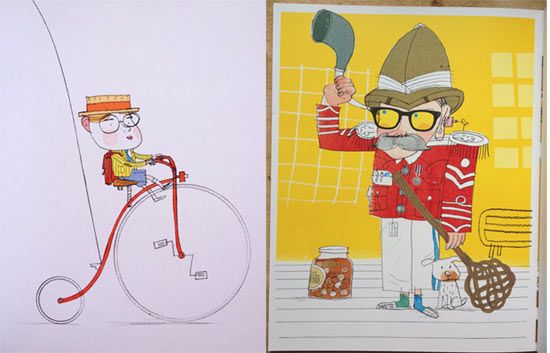
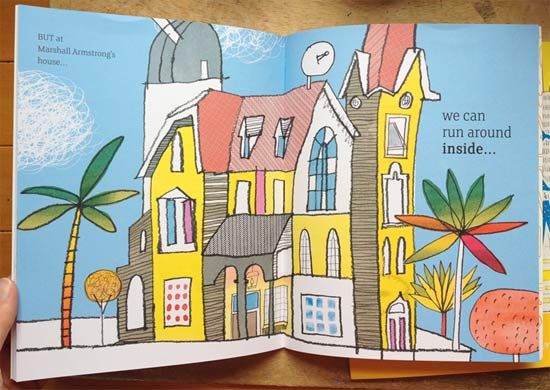
I talked a bit about self-publishing during the panel, and at the end, two members of the audience came up and gave me copies of their self-published books, The Enlightened Light Bulb Boy by Dublin-based Brazilian illustrator Tarsila Krüse and the Yum! Yum! Recipe Booklet by Tarsila and her friend Paula McGloin. 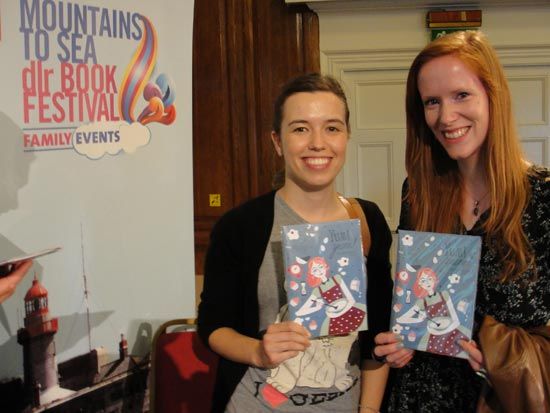
Googling their names, I saw their blog post about the annual Dublin Zine Fair, which looks like something worth visiting or taking part in if you're in town. 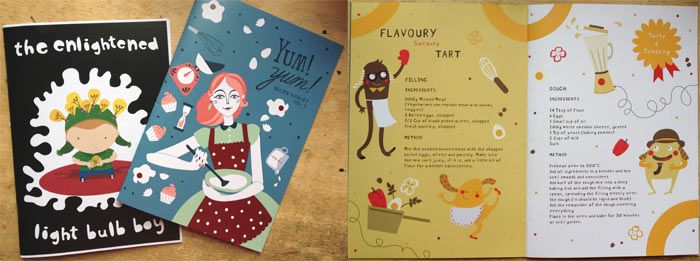
After the panel, CBI's Jenny Murray set me up for my interview for Inis magazine with Cethan Leahy, and we had a good chat.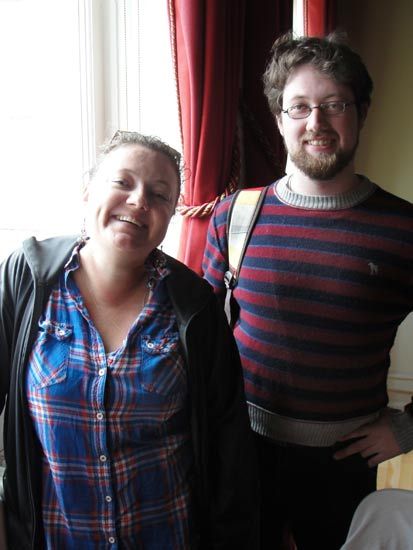
Then it was time to go home. Jenny whisked me off for a late lunch at the bagel place, then I got a festival taxi to the airport with Philip's agent, Philippa Milnes-Smith, and Sara Wingate Gray, who runs The Itinerant Poetry Library. Philippa and I listened, enthralled, to all the stuff Sara's been getting up to with her suitcase of poetry books, providing her 'guerilla public library service'. She was one of the first librarians to know about Twitter, which you can guess from her succinct Twitter name, @Librarian. I mentioned Audrey Niffenegger's graphic novel, The Night Bookmobile and short story Moths of the New World, and we decided that Sara had probably crawled out of the pages of one of those books before they were even written.
Oh, and this is my lovely new companion, a 'zonk' which I have named Webbster Donegan. She loves flying, even though her wings aren't terribly aerodynamic.
I was sad to leave. Someone tweeted a Dr Seuss quotation during the Paralympic Closing Ceremony that evening - 'Don't be sad it's over. Be glad it happened.' - and I thought that was a good way to look at it.
Goodbye, Ireland! An enormous thanks to Tom, Sarah, Marian, David, Jenny, Philip, CBI, Bob, Orla, the team of volunteers, and loads more people who made this festival such a wonderful experience. 
I feel like sleeping for a week now, and I'm sure the festival team do, too, but wow. That was amazing.
Blog: Welcome to my Tweendom (Login to Add to MyJacketFlap)
JacketFlap tags: Joanna Cotler Books, arc 9/12, Harper Collins Publishers, family, Friendship, dogs, fairies, adoption, first love, Ireland, small town life, jealousy, Add a tag
Naomi lives in the small town of Blackbird Tree. It is not named because of the shape of its trees, however, but for the many blackbirds that live in those trees. Blackbird Tree is a bit of a tragic place, where most of the children have experienced some sort of loss. Naomi is unsurprisingly a bit of a pessimist. After losing her mother as an infant, and her father in a tragic accident, she has been in the care of Joe and Nula. But she has always felt a little off kilter about the whole thing. What if someone comes to take her away? What if bad things instead of good things start coming out of the donkey's ear from the story that Joe tells?
One fateful day, a boy falls out of a tree right in front of Naomi. She's not sure if he's real or not-real, so she is happy when her friend Lizzie comes by and lets her know that she can indeed see this boy laying unconscious on the ground. Where Naomi dwells in the quiet places, Lizzie fills the air with her words, which can be both comforting and bothersome at once. She fusses over the boy when he comes to, and worries after "Finn boy" who says that he is staying up on the hill with the dim Dimmenses.
Finn has awoken something in Naomi, and she finds that she cannot stop thinking about him. Each time she runs into him she asks Finn about his life, but he would much prefer to talk to Naomi about hers. He seems odd, however, visiting the folks in town that others normally steer clear of - folks like Crazy Cora, or Witch Wiggins. When Finn asks Naomi where he can find Elizabeth Scatterding, who just happens to be Naomi's Lizzie, she finds herself consumed with jealousy.
Meanwhile over in Ireland, Sybil and her caretaker Miss Pilpenny are plotting revenge. Living at Rook's Orchard, Sybil has enlisted the help of a solicitor to help her with the perfect plan. There is a Finn boy who used to live there, as well.
Creech has woven together a magical story about family and friendship and the ties that bind. Each character, no matter how seemingly small is tied to another, and readers will find themselves spell bound from considering the ways in which this is possible in their own lives. Naomi herself often wonders about the connections between people and places -
"But I thought about all the things that had to have spun into place in order for us to be alive and for us to be right there, right then. I thought about the few things we thought we knew and the billions of things we couldn't know, all spinning, whirling out there somehow." (p 223 arc)
The Great Unexpected is a story that defies categorization in terms of story and of audience. Found within its pages are mystery and magic, old and young, boys and girls, rich and poor. I just finished it an hour ago, and I already want to read it again!
Blog: Drawing a Fine Line (Login to Add to MyJacketFlap)
JacketFlap tags: building rendering, architectural illustration, Enniskillen, building drawing, castle, Ireland, colored pencils, Prismacolors, Add a tag
Blog: Drawing a Fine Line (Login to Add to MyJacketFlap)
JacketFlap tags: castle, Irish, Ireland, Prismacolor, colored pencils, values, Ulster, Enniskillen, warm and cool greys, Add a tag
I've started on the castle itself, after lingering over the sky.
This is an old stone castle, so its scruffy and uneven and has irregular color patterns.
Its tricky sometimes to keep the colors and values in check, and describe the form accurately. What I mean is, you have values that describe the form, like the light and dark sides of the building. Then you have the changes in color in the stonework, which sometimes fight with the light/dark pattern. You might have dark stone on the light side of the building, for example, which goes against the ideal 'light to dark' way of rendering something.
To add to it all, there are also cool and warm colors of stone, which ideally would be placed to enhance your picture; but since this is real life, those are usually uncooperative as well. Cool colors would be in shadows, whereas the warm tones would be out front. So here we're dealing with a good range of greys, which are all over the place, and I'm doing my best to make them work, and still have it look like the place its supposed to be (which is Enniskillen Castle in Ulster).
Another thing that can help or hinder your drawing experience are the photos you have to work from. Sometimes you get great photos, but more often than not, you don't. Either some nice person who has commissioned your drawing has gone out and taken photos that are: too sunny, too dark, out of focus, while its raining, with cars blocking half the building, etc. etc etc. Or you get photos that have been tarted up with Photoshop filters to look all glowy and warm in the sun, when in fact the building is as grey as old dishwater. And on it goes. So the challenge is to find the truth in there somewhere, and do the best you can to make an accurate rendering. It can be a challenge! Here I'm splitting the difference between all my reference and making the best interpretation I can.
Blog: Shelf-employed (Login to Add to MyJacketFlap)
JacketFlap tags: graphic novel, book review, short stories, mystery, mythology, series, death, mothers, J, Ireland, Percy Jackson, grandmothers, digital audiobook, Advance Reader Copy, gods and goddesses, Add a tag
A little of this and a little of that, as I'm ahead in reading and behind in writing!
(short stories, novel, audiobook)
This book is an unexpected little gem, something of a mystery itself. From the cover, I was expecting a graphic novel mystery, a la The Box Car Children infused with a bit of magic. What I found instead, was a themed, graphic, short story collection. Mystery Boxes contains seven stories by noted graphic artists including Raina Telgemeier (Smile). What ties these disparate illustrators and authors together is that each story features a mysterious box, contents unknown. The stories range from amusing ("Spring Cleaning by Dave Roman and Telgemeier) to profound (Jason Caffoe's, "The Keeper's Treasure") to social commentary on war (Stuart Livingston and Stephanie Ramirez', "The Soldier's Daughter").
Judging from the way my Advance Reader Copy was scooped up by a child in my book club, I'd guess this will be popular if it can find the right audience. I'm also assuming that we can look forward to more collections in the Explorer series. I, for one, would like to see more interest in short stories. They don't seem to be required reading for middle schoolers - a pity. (Another good short story series, though not in graphic novel format, is Jon Scieszka's Guys Read Library)
Doyle, Roddy. 2012. A Greyhound of a Girl. New York: Amulet.
Advance Reader Copy
I chose to read this one because it features a multi-generational Irish family. It's hard not to like Ireland - a beautiful country full of "lovely" people. In fact, you will hear people in Ireland describe nearly anything as "lovely" --friendly people they are in general, but I digress.
This is the first Roddy Doyle book that I've read and I wasn't sure what to expect. I thoroughly enjoyed it once I stopped looking for some artificial contrivance or tricky plot twist and settled in to enjoy a simple yet touching story of 12-year-old Mary O'Hara, and three of her female relatives, one of whom happens to be dead. A Greyhound of a Girl covers a short span of time in a short book (208 small pages) about life and death and family. Being of Ireland, of course it is not without humor.
Riordan, Rick. 2011. The Son of Neptune, The Heroes of Olympus Series, Book 2. Read by Joshua Swanson. Listening Library.
12 hours, 27 minutes.
Blog: YA & MG Fantasy Author Rebecca Ryals Russell (Login to Add to MyJacketFlap)
JacketFlap tags: magic, Giveaway, Summer Reading, Ireland, Guest Post, Emily's House, Summer Teen Reading Hop, Natalie Wright, Add a tag
Readers, please welcome, as part of our Summer Teen Reading Party, Natalie Wright: author of Emily's House for YA readers. Thank you to Rebecca for having me as a guest on her blog today. The Summer Teen Reading Party is in full swing! How many contests have you entered so far? Have you snagged any fun summer reads for your e-reader? In my novel, Emily’s House, Emily must learn how to focus her magical abilities. One of my goals when writing Emily’s House was to embed a primer for “real magic” into the story. Here is my favorite story of real magic and how I used it to win a trip to Ireland! Continue reading
Add a CommentBlog: Shelf-employed (Login to Add to MyJacketFlap)
JacketFlap tags: rhyming, favorites, spring, gardening, storytime, Ireland, picture books for older readers, trucks, E, mummies, Add a tag
As the co-organizer of the KidLit Celebrates Women's History Month blog, I've been very busy formatting, posting, and reading all of the great guest posts this month. (If you haven't checked it out, you're missing some great essays and reviews.) As a consequence, I've been neglecting to post often this month, but today I have a quick rundown of three titles that grabbed my attention this past week:
- Fogliano, Julie. 2012. And then it's spring. Illustrated by Erin E. Stead. New York: Roaring Brook.
I loved this book from the minute I saw the cover staring at me from my book delivery bag. It's simply perfect. Betsy Bird, of Fuse #8, named it to her early Caldecott predictions list yesterday. Get yourself a copy if you can.
- Sutton, Sally. 2012. Demolition. Illustrated by Brian Lovelock. Somerville, MA: Candlewick.
Bright colors, realistic trucks, repeated refrains, rhymes with perfect rhythm - a storytime book doesn't get much better than this. If you know any small children at all, you know one who will like Demolition.

And finally, a curious addition to my bag 'o books,
- Bunting, Eve. 2011. Ballywhinney Girl. Illustrated by Emily Arnold McCully. New York: Houghton Mifflin Harcourt.
Blog: Here in the Bonny Glen (Login to Add to MyJacketFlap)
JacketFlap tags: pinterest, Connections, Fun Learning Stuff, Ireland, rabbit trails, Add a tag
Today we read a chapter from H.E. Marshall’s English Literature for Boys and Girls:
But of one of the great treasures of old Irish literature we will talk. This is the Leabhar Na h-Uidhre, or Book of the Dun Cow. It is called so because the stories in it were first written down by St. Ciaran in a book made from the skin of a favorite cow of a dun color. That book has long been lost, and this copy of it was made in the eleventh century…
In the Book of the Dun Cow, and in another old book called the Book of Leinster, there is written the great Irish legend called the Tain Bo Chuailgne or the Cattle Raid of Cooley.
This is a very old tale of the time soon after the birth of Christ. In the book we are told how this story had been written down long, long ago in a book called the Great Book Written on Skins.
That last bit cracked us up and we had to spend a while proclaiming the title in sonorous tones.
We enjoyed the story of the Book of the Dun Cow even more than the story in the Book of the Dun Cow, if you see what I mean. Marshall drops in intriguing details and doesn’t explain them: “But a learned man carried away that book to the East.” Who? Why? Where?
We’d have liked to hear more of Mary A. Hutton’s poem, “The Tain,” of which only a snippet was included—the Brown Bull’s death:
“He lay down
Against the hill, and his great heart broke there,
And sent a stream of blood down all the slope;
And thus, when all the war and Tain had ended,
In his own land, ‘midst his own hills, he died.”
 Later we decided it was time for Rilla to meet The King of Ireland’s Son, and Padraic Colum’s rollicking, lilting prose swept us off on a grand adventure. Oh, such chills when the Eagle looks at the King’s Son with the “black films of death” covering her eyes!
Later we decided it was time for Rilla to meet The King of Ireland’s Son, and Padraic Colum’s rollicking, lilting prose swept us off on a grand adventure. Oh, such chills when the Eagle looks at the King’s Son with the “black films of death” covering her eyes!
Hmm, this is all sounding rather gruesome, but I guess I’m just calling out the gruesome bits. We were laughing ourselves silly at certain parts of the morning’s reading. And Colum weaves in such irresistible poetry:
His hound at his heel,
His hawk on his wrist;
A brave steed to carry him whither he list,
And the green ground under him,
and
I put the fastenings on my boat
For a year and for a day,
And I went where the rowans grow,
And where the moorhens lay;And I went over the stepping-stones
And dipped my feet in the ford,
And came at last to the Swineherd’s house,–
The Youth without a Sword.A swallow sang upon his porch
“Glu-ee, glu-ee, glu-ee,”
“The wonder of all wandering,
The wonder of the sea;”
A swallow soon to leave ground sang
“Glu-ee, glu-ee, glu-ee.”
I’m using Pinterest to create a little scrapbook of our Ireland rabbit trail—it suddenly made sense to me last night how that’s a perfect platform for collecting all the books, pictures, and websites we tend to explore in the pursuit of a particular interest.
Here’s a clip of some Irish
Add a CommentBlog: Cartoon Brew (Login to Add to MyJacketFlap)
JacketFlap tags: US, France, Ireland, Argentina, Animated Fragments, Ace & Son, Camille Chabert, Chris O'Hara, Kelsey Stark, Marine Feuillade, Naïmé Perrette, Natalianne Boucher, Stephen McNally, Váscolo, Add a tag
FoxRetro X-Mas Spot by Váscolo (Argentina)
Thor facial rig test in Softimage by Stephen McNally (Ireland)
Strip Tease by Natalianne Boucher, Camille Chabert, Marine Feuillade and Naïmé Perrette (France): “The technique consists of ‘cut-out’ animation (cutted paper, here added to tissues) then back projected on a wall and shot frame by frame.”
African plains, manes and stolen meals by Chris O’Hara (Ireland): “Featuring audio from Planes, Trains and Automobiles.“
X-Ray, Ace & Son studio bumper by Kelsey Stark (US)
Cartoon Brew: Leading the Animation Conversation |
Permalink |
3 comments |
Post tags: Ace & Son, Argentina, Camille Chabert, Chris O'Hara, France, Ireland, Kelsey Stark, Marine Feuillade, Naïmé Perrette, Natalianne Boucher, Stephen McNally, US, Váscolo
Blog: TWENTY TEN Bridget Whelan (Login to Add to MyJacketFlap)
JacketFlap tags: Ireland, Donegal, short list, Prix Goncourt, Add a tag
The PRIX GONCOURT - the tres prestigious French literary prize - goes through
four rounds: a longlist, a shortlist, a shorter list (which was announced today) until finally a winner is declared who must be living on his or her nerves by the time the announcement is made, surviving on a diet of nails (the handy kind that are easy to nibble) and strong drink.
The four books on this year's short short list are:
- L'Art français de la guerre by Alexis Jenni
- La belle amour humaine by Lyonel Trouillot
- Du Domaine des Murmures by Carole Martinez
- Retour à Killybegs by Sorj Chalando
As I was reading websites with my French English dictionary in one hand and my finger poised over the Google translate this now button, I can't tell you much more except that some folk seemed to think that Killybegs is in Northern Ireland.
Given the novel's subject, it's an easy mistake for commentators to make. (I am sure the author didn't make it.) Donegal, however, is in southern Ireland - in the Irish Republic.
It is though the most northerly part of the island of Ireland. There, that's cleared that up.
Blog: OUPblog (Login to Add to MyJacketFlap)
JacketFlap tags: *Featured, black and tan, irish history, auxilaries, black and tans, d. m. leeson, i.r.a., irish war of independence, tans, laurentian, leeson, ambush, “fake”, fergus, cadets, History, UK, photography, photograph, irish, ireland, Europe, police, Add a tag
By D. M. Leeson In September 2010, when my book was just about to enter production, my editor asked me if I had any ideas about an image for the cover.
Blog: OUPblog (Login to Add to MyJacketFlap)
JacketFlap tags: Poetry, Literature, Videos, folklore, yeats, faeries, Multimedia, irish, ireland, mage, foster, w b yeats, occult, Humanities, apprentice, *Featured, r. f. foster, roy foster, words alone, Add a tag
W. B. Yeats is usually seen as a great innovator who put his stamp so decisively on modern Irish literature that most of his successors worked in his shadow. R. F. Foster's new book, Words Alone: Yeats and his Inheritances, weaves together literature and history to present an alternative perspective.
Blog: Sarah McIntyre (Login to Add to MyJacketFlap)
JacketFlap tags: ireland, dublin, Add a tag
Hey, look at the poster that just popped up on the Inis magazine blog!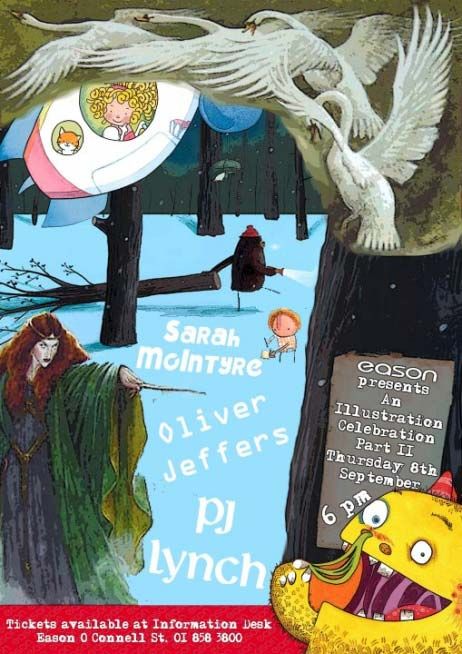
If you're anywhere near Dublin this Thursday, come join me and two top-notch illustrators Oliver Jeffers and PJ Lynch at the big Easons on O'Connell Street for a cosy evening event! I'm looking forward to finding out more about PJ Lynch and I'm already a huge fan of Oliver's work. I remember the first time I saw an original piece he'd done for The Incredible Book Eating Boy, I was totally blown away because none of it was digital (as I'd assumed), he'd really found all this beautiful old paper and things and cut and pasted and painted it together. 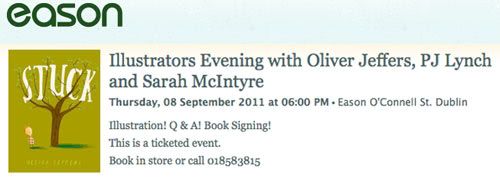
I've really enjoyed my trips to Ireland the past couple years (see past blog posts here). My studio mate, Gary Northfield and I did an amazing whistle-stop tour last year. You might have already seen this, but I'll post the video of our slot on RTE2 Irish kids telly, that was such good fun.
(Click here for Part 2)
Blog: Cartoon Brew (Login to Add to MyJacketFlap)
JacketFlap tags: CGI, Ireland, Student, Ferg Brennan, IADT Dun Laoghaire, Add a tag
The sixth film in our Student Animation Festival, The Fisherman, comes to us from Ferg Brennan who produced it at the Dun Laoghaire Institute of Art Design and Technology in Dublin, Ireland. To comment on the film or read extensive behind-the-scenes notes from the filmaker, click HERE.
The film is an incredible piece of theater, a dark psychological drama with an exquisite monologue performed by Irish actor Diarmuid De Faoite. Brennan’s CG animation fits the narrative perfectly, and his stylized design of the lead character captures the manic despair of the lonely, lower class fisherman. It’s the acting, by both voice actor and animator, that pulls the film together—and (pardon the pun) reels the viewer totally in. The film’s sophistication stands apart with its powerful portrayal of a man facing his own madness.
Cartoon Brew’s second annual Student Animation Festival is made possible through the generous support of Titmouse and JibJab.

Cartoon Brew: Leading the Animation Conversation |
Permalink |
No comment |
Post tags: Ferg Brennan, IADT Dun Laoghaire, Ireland
Blog: Cartoon Brew (Login to Add to MyJacketFlap)
JacketFlap tags: Ireland, BrewTV, Ferg Brennan, IADT Dun Laoghaire, Add a tag
The sixth film in our Student Animation Festival, The Fisherman, comes to us from Ferg Brennan who produced it at the Dun Laoghaire Institute of Art Design and Technology in Dublin, Ireland.
The film is an incredible piece of theater, a dark psychological drama with an exquisite monologue performed by Irish actor Diarmuid De Faoite. Brennan’s CG animation fits the narrative perfectly, and his stylized design of the lead character captures the manic despair of the lonely, lower class fisherman. It’s the acting, by both voice actor and animator, that pulls the film together—and (pardon the pun) reels the viewer totally in. The film’s sophistication stands apart with its powerful portrayal of a man facing his own madness.

Brennan (above) provided us with some background on making The Fisherman:
The thing I was most apprehensive about was working with an actor for the first time. The idea of having somebody else reading lines that I had written was intimidating, however Diarmuid made it easy for me by being so gracious and professional. The bulk of the narration is a contiguous section of the first take- he basically nailed it first time which was a huge relief. The recording happened in a makeshift sound booth constructed by some friends of mine, whose band had some audio equipment. I was nervous about the sound quality but they did a great job and we were able to create a professional atmosphere despite the fact that it all took place in a booth covered with duvets in the corner of a living room.
The story is inspired by the Irish myth of “The Salmon of Knowledge”, in which a character gains “all of the world’s knowledge” by eating a special salmon. I liked the idea of taking an idea from an old story with a uniquely Irish identity, but then completely imposing my own artistic sensibilities onto it. It was also important to me that a viewer wouldn’t have to get all the references to find the film engaging, so I tried to emphasize the character and the emotional content.
I’d be interested to hear what people think of the film, and happy to answer any questions.
Filmmaker Websites:
Check out Ferg Brennan’s personal website, his Fisherman’s blog and this link to his other films.
Cartoon Brew’s second annual Student Animation Festival is made possible through the generous support of Titmouse and JibJab.
Cartoon Brew: Leading the Animation Conversation |
Permalink |
No comment |
Post tags: Ferg Brennan, IADT Dun Laoghaire, Ireland
Blog: Schiel & Denver Book Publishers Blog (Login to Add to MyJacketFlap)
JacketFlap tags: Ireland, franchise, Lisa Campbell, Eason, bookselling, booksellers, Add a tag
Eason is opening four new franchise stores in Ireland as it appeals for more people to become franchisees.
The Irish bookseller said it was "keen to encourage individuals and businesses" to explore the Eason franchise model as it opened a new franchise store in Mullingar yesterday (Thursday 28th July).
Add a CommentBlog: Schiel & Denver Book Publishers Blog (Login to Add to MyJacketFlap)
JacketFlap tags: Ireland, The Book Depository, Graeme Neill, Amazon, booksellers, Add a tag
The Irish Competition Authority has cleared the acquisition of The Book Depository by Amazon after a three-week investigation into the deal. In a short statement, the authority said: "[We have] formed the view that the acquisition will not lead to a substantial lessening of competition in any markets for goods or services in the state."
It said it will publish its reasons in full no later than 25th September but is allowing the relevant parties to remove any confidential information from the published version.
Add a CommentBlog: OUPblog (Login to Add to MyJacketFlap)
JacketFlap tags: History, Reference, Current Events, World, irish, ireland, anniversaries, Europe, catholic, belfast, *Featured, act of union, irish history, march 17, s j connolly, patrick’s, including contested, ulster, shamrocks, st patrick's day, protestant, sean connolly, Add a tag
By S. J. Connolly
The approach of St Patrick’s day brings to mind once again the ambivalent relationship that historians have with festivals and anniversaries. On the one hand they are our bread and butter. Regular commemorations are what keep the past alive in the public mind. And big anniversaries, like 1989 for historians of the French Revolution, or 2009 for historians of Darwinism, can provide the occasion of conferences, exhibitions, publishers’ contracts, and even invitations to appear on television. On the other hand, historians are trained to look behind supposed traditional observances for the discontinuities and inventions they conceal. They also see it as an important part of their role to point up the gaps between myth, whether popular or official, and what actually happened. All this tends to cast them in the role of spoilsport. When the emphasis is on commemoration, who wants a curmudgeon in the corner pointing out that Britain’s Glorious Revolution was really an evasive compromise that evades the great issues of political principle that were at stake, or that William Wallace was not really Scottish?
Where Ireland is concerned, these issues are all the more familiar, because there anniversaries retain a political significance that elsewhere they have largely lost. In 1991 the Irish government was attacked for its failure to celebrate the 75th anniversary of the rising of 1916. Later in the decade, with republican violence in Northern Ireland suspended and the economy booming, there was a greater willingness to embrace a frankly nationalist version of the Irish past. Events to mark the sesquicentenary of the outbreak of the Great Famine of 1845-51 got stridently under way in 1995, with a renewed emphasis on the crisis, not as a natural disaster, but as a wrong done to the Irish people. Next came the even more enthusiastic celebrations accorded to the rebellion of 1798, presented as a time when Catholic and Protestant supposedly united behind shared national and democratic goals, and hence as a blueprint for post-ceasefire Ireland.
Since then, the urge to commemorate has abated somewhat. The centenary of the act of union (2000) was a muted affair, while the anniversary of Robert Emmett’s insurrection in 1803 was perhaps a victim of the overkill of 1998. Today, however, we can see, looming ahead of us like icebergs out of the fog, a succession of further centenaries to which we will have to find an appropriate response: 1912, when Ulster Protestants, through the mobilization of the Ulster Volunteer Force, took command of their own destiny but also set Ireland on the road to civil war; 1916, the actual centenary (as opposed to the questionable seventy-fifth anniversary) of the Easter Rising; 1920 and 1922, the foundation of two states within a divided Ireland.
Against this uninspiring background St Patrick’s day stands out as a more benign event. Ireland’s patron saint, it is true, has not always been an uncontentious figure. Over several centuries ecclesiastical historians engaged in a frankly partisan debate over whether what Patrick had established was a faithful part of papal Christianity or a proto-Protestant church independent of the authority and doctrinal errors of Rome. Today, in a more secular age, these controversies are largely forgotten. Instead 17 March provides the occasion for a good natured round of parading, celebration and the flourishing of shamrocks and shillelaghs, whose observance extends well beyond Ireland itself. Indeed it is one of the curious features of the event that it is in Washington, rather than Dublin, that senior members of the Irish government are generally to be found on their country’s national day.
Perhaps the most interesting recent developments in the history of St Patrick’s Day have taken place in Belfast. 17 March,
View Next 25 Posts



















This sounds delightful! I'm so glad to have found your blog. :) I'm working on my Master's in secondary English education, hoping to to teach middle school, so I'm always looking for great recommendations for middle grades books. Excellent review, I can't wait for this to be released!